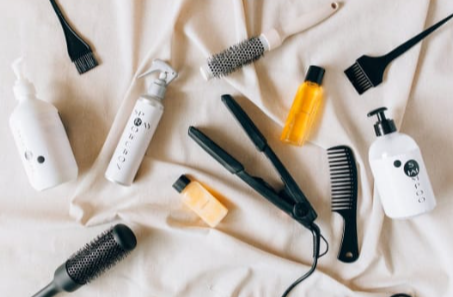Hair Straightener Chemicals and The Risk of Endocrine Disruption

Silky, straight locks are a coveted look, but what if achieving them comes at a hidden cost? Recent studies raise alarming concerns about the chemicals lurking in hair straighteners and their potential to disrupt your body’s delicate hormonal balance.
Every straightening session could silently play out endocrine disruption, linked to serious health problems. Is your desire for sleek hair putting your health at risk?
Join us as we delve into the science behind these concerns and advocate for a beauty industry that prioritizes your well-being over picture-perfect strands.
Understanding Endocrine Disruption
Our bodies rely on a complex interplay of hormones. They play a crucial part in various functions, ranging from growth in height to the burning of food for energy. However, a silent threat can disrupt this delicate harmony: endocrine disruptors.
Certain chemicals act as imposters, mimicking natural hormones and triggering exaggerated responses within the body. Imagine a growth hormone stimulating muscle mass buildup or insulin production occurring at inappropriate times.
Another tactic employed by these disruptors is the blockade of hormone receptor sites. These molecular roadblocks prevent essential hormones from binding to their intended targets, silencing their messages.
Finally, some endocrine disruptors exert a more direct influence, acting as hormonal superchargers or brakes. They can stimulate the endocrine system to overproduce hormones. This can lead to conditions like an overactive thyroid or, conversely, suppress production, resulting in an underactive one.
The biggest danger from these endocrine disruptors comes from their ability to exert their effects even at low levels of exposure. These windows are especially vulnerable. This includes the critical development period in the womb (in utero) and during puberty.
Moreover, exposure to endocrine-disrupting chemicals during childhood has been associated with developmental abnormalities and neurobehavioral problems in children.
Chemicals of Concern in Hair Straighteners
To achieve the straightening effect, hair straighteners formulate a blend of various chemicals. However, several of these ingredients are potent enough to cause excruciating damage to the body.
Let’s dive deep into the chemical infiltrators lurking within these seemingly innocuous products.
Phthalates
Phthalates are plasticizers that enhance the flexibility and durability of hair straighteners. These toxins can mimic or antagonize the effects of natural hormones, leading to a wide range of adverse health outcomes.
Numerous studies have linked phthalate exposure to reproductive irregularities. These comprise decreased sperm count and motility in men, and ovulatory disorders and endometriosis in women.
Moreover, they can cross the placental barrier and accumulate in breast milk. The potential long-term impact on fetal and infant health is a significant cause for concern.
Parabens
Hair straighteners frequently incorporate parabens to extend product shelf life. However, they have come under intense scrutiny for their estrogenic properties. These chemicals can mimic estrogen, sparking worries regarding their link to cancers influenced by hormones.
Disturbingly, parabens have also been detected in breast cancer tissues. Long-term exposure can lead to the development of this devastating disease.
This has led to several hair straightener cancer lawsuits against manufacturers of hair straightening products. Plaintiffs allege that cosmetic companies, like L’Oreal, underplayed the life-threatening risks posed by their products.
Other Potential Endocrine-Disrupting Chemicals
Researchers have identified several other chemicals in hair straighteners as potential endocrine disruptors. These include bisphenol A (BPA), which is used in some product packaging, and heavy metals like lead and mercury, which can be contaminants.
Studies suggest a connection between BPA exposure and various health concerns, including metabolic disruptions and specific cancers.
Lead and mercury can accumulate in the body over time, leading to neurodevelopmental deficits, reproductive problems, and immune system dysfunction.
It’s worth mentioning that not every hair straightener contains these detrimental substances. Nevertheless, as advised by TorHoerman Law, it’s prudent to exercise caution and awareness when selecting a straightening product.
A Regulatory Gap in the Beauty Landscape
The pursuit of beauty often leads us to trust the products adorning store shelves. However, the cosmetics industry’s regulatory landscape is a cause for concern.
The regulatory framework for cosmetics in the United States stands in stark contrast to that of pharmaceuticals. The Food and Drug Administration (FDA) is not authorized to grant pre-market approval for cosmetic products.
This creates a system of self-regulation, placing the onus of safety on the shoulders of cosmetic companies.
Leading brands, like L’Oreal, Dark & Lovely, and Just For Me, exploit this void. They inadvertently indulge in misleading marketing practices, undermining. This leaves consumers, like you, vulnerable to unforeseen health consequences.
Empowering Yourself: Knowledge is Power
While regulations evolve, the power to make informed choices rests with you. Here’s how to navigate this landscape.
Seek Safer Alternatives
Heat Protectants: Look for brands specifically formulated “free of endocrine disruptors,” “paraben-free,” or “phthalate-free.”
To explore safety ratings and research individual product ingredients, consult the Environmental Working Group’s (EWG) Skin Deep database.
Alternative Straightening Methods: Explore keratin treatments or ceramic straightening brushes that utilize heat to achieve straighter styles with potentially less chemical exposure.
Experiment with embracing your natural texture. You can always explore online tutorials and product recommendations for natural hair care.
Advocate for Change
Support Safe Cosmetics: Organizations like the Campaign for Safe Cosmetics advocate for stricter regulations and safer beauty products. Consider donating or volunteering to support their efforts.
Demand Transparency: Contact your favorite brands directly. Ask them about their ingredient sourcing, safety testing practices, and commitment to using endocrine-disruptor-free formulations.
Go ahead and share your concerns on social media using relevant hashtags like #SaferBeauty and #EndocrineDisruptors.
See Also: How a Small Business Coach in Brisbane Can Skyrocket Your Growth
Stay Informed
Scientific Journals: Websites like the National Institutes of Health and the Endocrine Society publish research on endocrine disruption. Explore their databases for the latest scientific findings.
Independent Beauty Blogs and Websites: Look for reputable sources focused on clean beauty and non-toxic living. These platforms often provide product recommendations, ingredient breakdowns, and insights into the latest industry trends.
By taking these steps, you empower yourself to navigate the beauty industry with confidence. Remember, prioritizing your health is paramount. You can achieve your desired look while advocating for a future where beauty and wellness go hand-in-hand.


